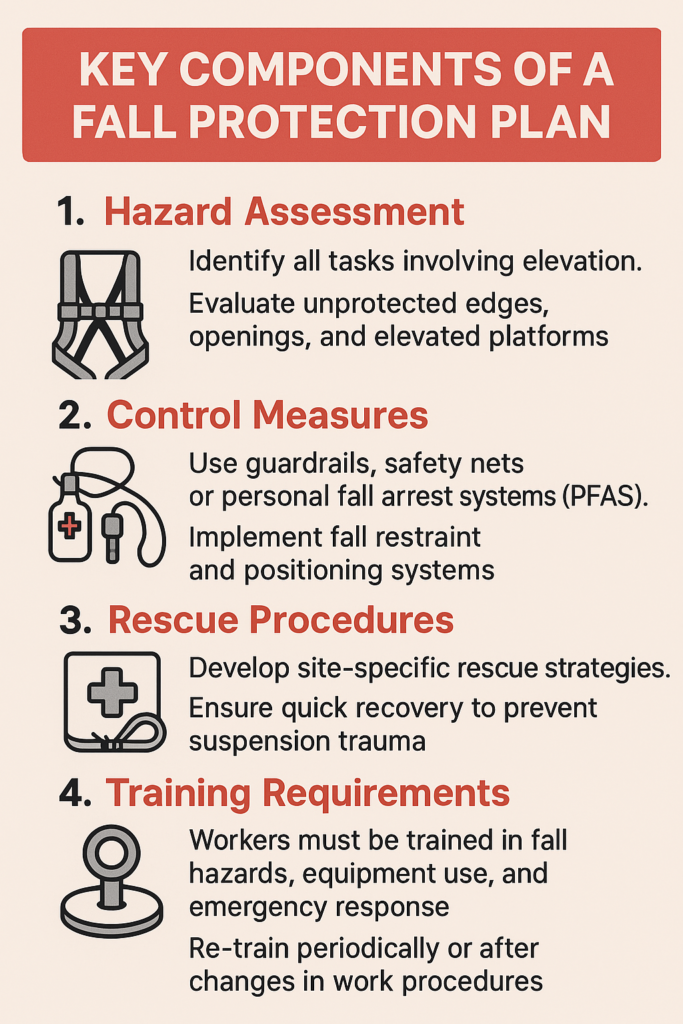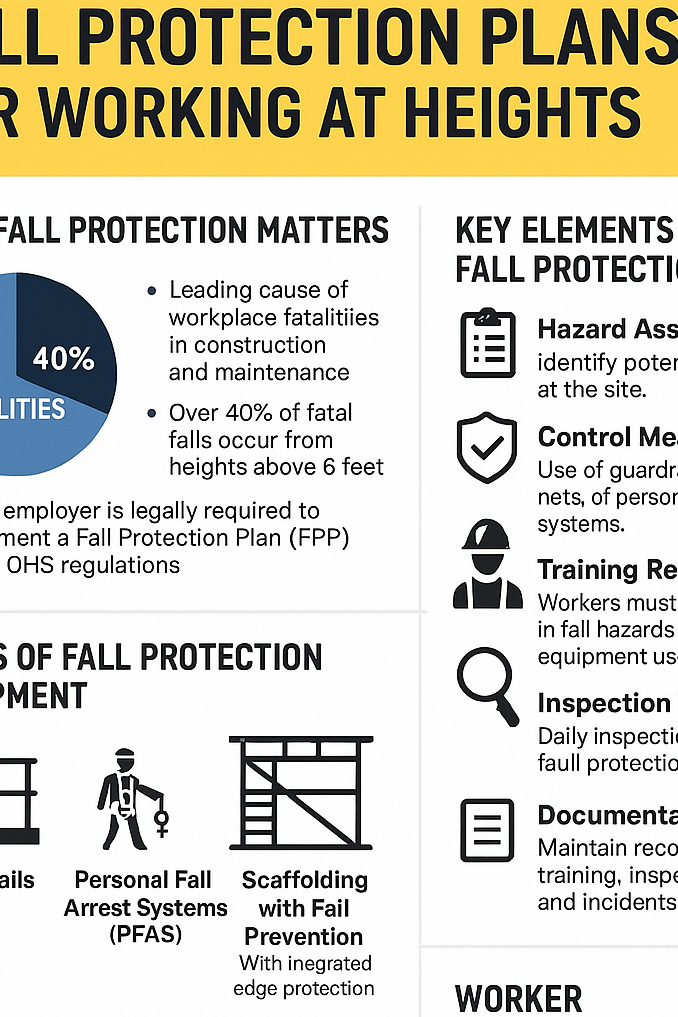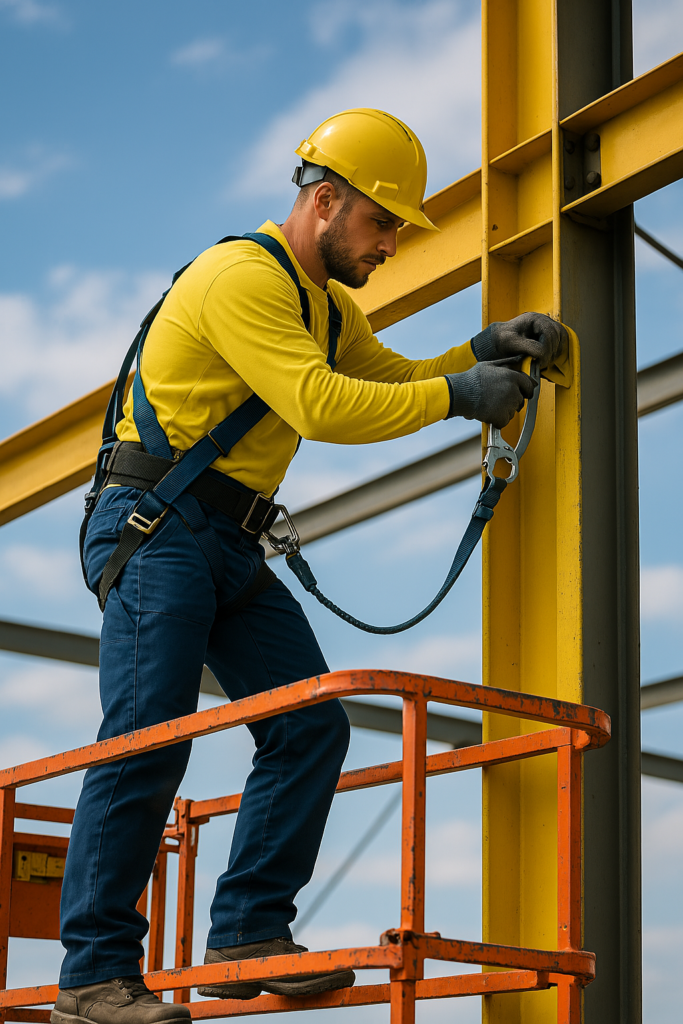- Fall Protection Plans for Working at Heights: Stay Grounded, Stay Alive
- Understanding the Importance of Fall Protection
- What Does a Fall Protection Plan Include?
- Types of Fall Protection Equipment Featured
- Worker Responsibilities in a Fall Protection Plan
- Emergency Rescue Planning Is Non-Negotiable
- Why Infographics Make a Difference in Safety Training
- Final Thoughts on Fall Protection Plans for Working at Heights
Fall Protection Plans for Working at Heights: Stay Grounded, Stay Alive
Fall Protection Plans for Working at Heights are not just a regulatory requirement—they are a life-saving strategy. Falls continue to be one of the leading causes of injuries and fatalities in construction, warehousing, maintenance, and utility work.



Our newly designed infographic helps simplify this critical topic by breaking down the key components every workplace needs to implement for working at height safely and effectively.
Understanding the Importance of Fall Protection
Every year, preventable falls from heights cause serious injuries and deaths across industries. According to WorkSafeBC, a properly implemented fall protection plan could significantly reduce these numbers.
Whether it’s a 3-meter scaffold or a 20-foot lift, having a fall protection plan in place is essential to ensure worker safety, legal compliance, and operational efficiency.

What Does a Fall Protection Plan Include?
Our Fall Protection Plans for Working at Heights infographic highlights six key components:
- Hazard Assessment: Evaluating all potential fall risks at the site.
- Control Measures: Choosing the right combination of guardrails, safety nets, and fall arrest systems.
- Training Requirements: Ensuring that every worker understands the risks and how to use fall protection gear correctly.
- Equipment Inspection: Verifying that all safety gear is maintained and in good condition.
- Rescue Procedures: Outlining detailed plans for rapid rescue in case of a fall.
- Documentation: Keeping track of safety checks, training logs, and plan updates.
For a detailed breakdown, refer to the infographic or check resources from Canadian Centre for Occupational Health and Safety (CCOHS).
Types of Fall Protection Equipment Featured
The infographic illustrates vital equipment used in fall prevention and arrest, including:
- Guardrails
- Personal Fall Arrest Systems (PFAS)
- Safety nets
- Scaffolding with edge protection
Each tool serves a different purpose, and choosing the right one depends on the task, location, and risk level. OHSE.ca offers in-depth articles about each of these systems and how they should be deployed correctly.
Worker Responsibilities in a Fall Protection Plan
Even with the best equipment and plans, worker participation is key. The infographic reminds all workers to:
- Always wear designated PPE
- Never disable or bypass safety systems
- Inspect gear before every use
- Report any damage or unsafe conditions immediately
These actions align with safety best practices outlined in your company’s Occupational Health and Safety Program and provincial guidelines.
Emergency Rescue Planning Is Non-Negotiable
One of the most overlooked parts of a fall protection strategy is rescue readiness. According to NIOSH, the time between a fall and a rescue attempt can make a life-or-death difference. Your fall protection plan must:
- Assign rescue roles and train team members
- Outline communication procedures
- Conduct quarterly drills
- Ensure first aid is immediately accessible
Why Infographics Make a Difference in Safety Training
Infographics are an excellent way to communicate complex information quickly and effectively. This Fall Protection Plans for Working at Heights infographic can be posted on job site bulletin boards, used during safety meetings, or integrated into eLearning modules.

Using visual tools helps reinforce safety culture, especially in high-risk environments. You can also explore similar resources in our internal Safety Blog Section to further educate your team on best practices.
Final Thoughts on Fall Protection Plans for Working at Heights
Every minute spent planning for fall protection is a minute spent saving lives. This infographic is designed to serve as a quick, clear, and compliant guide to understanding the Fall Protection Plans for Working at Heights.
Whether you’re a safety officer, supervisor, or crew member, you have a role to play in preventing falls and ensuring everyone gets home safely.

No comments yet